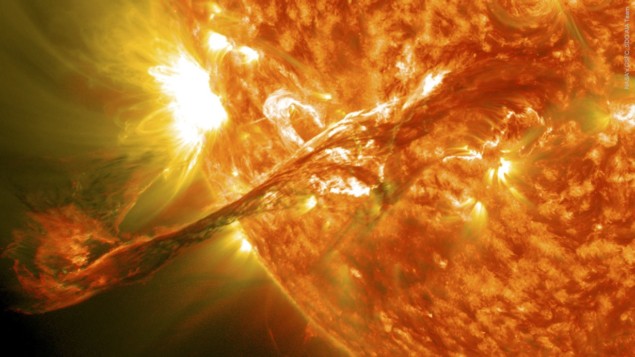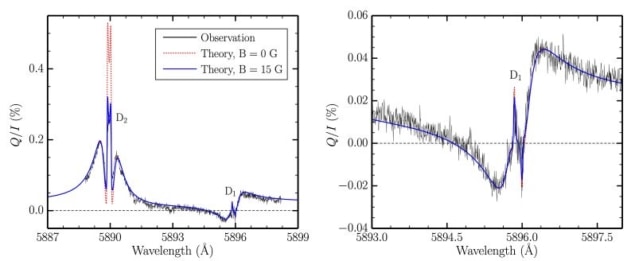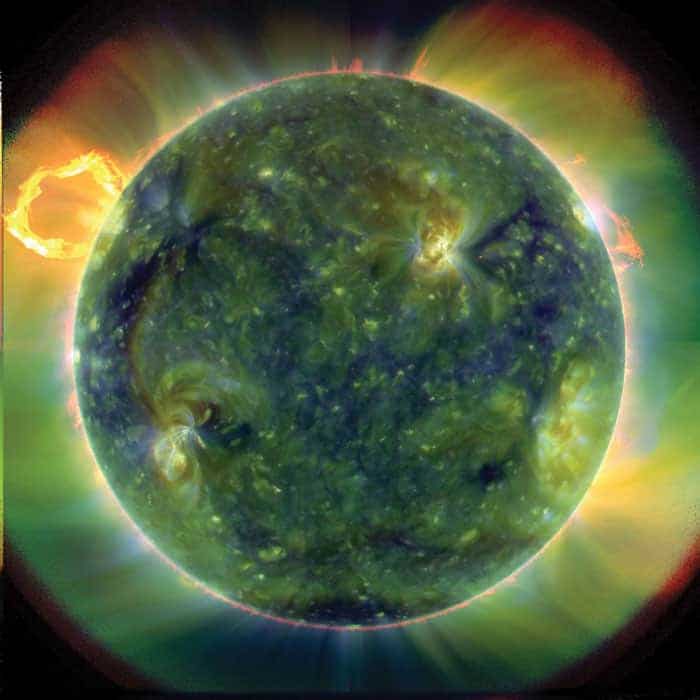
A paradox that puzzled a generation of solar and atomic physicists – and occasionally pitted theories from one field against the other – has been resolved. The paradox concerns the polarization of light at a specific point in the solar spectrum, and previous attempts to explain it required either an extreme reduction in the Sun’s magnetic field (which solar physicists deemed unlikely) or changes to the physics of atom-photon interactions (which atomic physicists did not observe). The latest research, however, indicates that no such adjustments are needed. Instead, careful numerical modelling showed that the discrepancy between solar observations and atomic theory vanishes after complex, previously neglected interactions are taken into account.
Most sunlight is at least partly linearly polarized, and the reasons are generally well-understood. Because atoms in the solar atmosphere absorb more photons from “behind” them (that is, from the direction of the Sun), conservation of angular momentum means that some of their spin sublevels become more populated than others. When the atoms then decay back to their ground state, they emit more photons from these populated sublevels, leading to polarized emissions.
The paradox of the sodium D1 line
The current polarization puzzle originated in 1996, when astrophysicists Jan Stenflo of ETH Zurich in Switzerland and Christoph Keller (then at the US National Solar Observatory in Arizona) used an instrument called ZIMPOL (Zurich Imaging Polarimeter) to study solar radiation at a wavelength of around 589nm. This wavelength corresponds to a perturbation in the Sun’s spectrum caused by sodium atoms in the solar chromosphere absorbing photons and then emitting them from multiple sublevels of an excited state.
While theory predicted that emissions from this so-called sodium D1 line should not be polarized, Stenflo and Keller’s observations suggested otherwise. “If the line in question were not polarizable, you would see a decrease in polarization with respect to the baseline, because the transition would simply be absorbing [partially polarized] radiation and re-emitting non-polarized radiation,” explains solar physicist Ernest Alsina Ballester of Switzerland’s Università della Svizzera Italiana (USI), now working at the Instituto de Astrofísica de Canarias (IAC) in Tenerife, Spain. “What you get is polarization added.”
Two years later, Egidio Landi Degl’Innocenti of the University of Florence, Italy tried to explain this anomaly by noting that emissions from the D1 line could be polarized if the ground state involved in this transition was itself polarized. However, Landi Degl’Innocenti readily admitted to a problem with this proposal: it could only be true if the magnetic field in the solar chromosphere was less than 0.01 G. Any higher, and the ground state would be depolarized by the so-called Hanle effect. Unfortunately, such a tiny magnetic field conflicted with observations of other spectral lines (largely by Stenflo and Keller) as well as arguments from plasma physics suggesting that the field must be orders of magnitude stronger. “If the chromosphere is magnetized there was no available explanation for this spectral line to be produced,” summarizes Alsina Ballester. “This became known as the paradox of the sodium D1 line.”
A search for explanations
Over the next quarter-century, various researchers proposed creative solutions to this paradox. Stenflo and others suspected that the quantum theory of scattering needed modification. “This seemed to be more compelling than the idea that the chromosphere was truly unmagnetized, which would have led to many problems in our current understanding of the solar atmosphere,” Alsina Ballester says. Atomic physicists duly designed laboratory experiments to test this idea using broadband radiation, lasers and other light sources, but nothing conclusive was found.
The first real hint appeared in 2013, when Luca Belluzzi and Javier Trujillo Bueno of the IAC showed that if the radiation anisotropy the sodium atoms perceive varies with wavelength across the tiny absorption bandwidth of the D1 transition, this could produce polarized emission without a polarized ground state. Previously, Alsina Ballester explains, “it had typically been assumed that it was a good approximation to neglect these variations”. The only problem was that at the time, there was no theoretical framework that would have allowed Belluzzi and Trujillo Bueno to incorporate a magnetic field into this model and thereby extract predictions to compare with astronomical observations.

In 2017, Véronique Bommier of the Paris Observatory developed such a framework. According to Alsina Ballester, a key aspect of Bommier’s work is that it accounts for frequency correlations between incoming and scattered radiation. Armed with this information, Belluzzi (now at the USI), Trujillo Bueno and Alsina Ballester constructed a detailed prediction of the polarization of the light from the sodium D1 line. They then made their own observations using ZIMPOL-3 – a third-generation version of Stenflo and Keller’s instrument – and found almost perfect agreement with their predictions.
Scattering theory enters the mainstream
Bommier is impressed with the new research, which appears in Physical Review Letters. “They obtain excellent agreement between theory and observation, and I think that this is, in itself, a kind of proof that this is a polarization profile of the sodium D1 line,” she says. In her view, however, the study’s most important result is that the researchers observed no net polarization when they integrated their results across the entire absorption spectrum of the D1 line (opposite polarization is seen at different wavelengths, producing a sum consistent with zero). This differs from Stenflo and Keller’s original observations, and Bommier argues that the net polarization they saw may have been an observational artefact. “This was the paradox,” she says. “There was a disagreement between quantum mechanics and Stenflo’s original observations.”
The study’s authors declined to comment on this suggestion, saying only that “a careful analysis is still needed”. Stenflo’s response is to point out that the new observations show that the polarized D1 profile shape varies with spatial location on the Sun, and at some places there is more net polarization than at other places. “The authors selected one particular observed D1 profile and showed that it could be explained in terms of their theory when accounting for the spectral structure of the pumping radiation in the scattering process,” Stenflo says. “While this is a significant result, they have not yet demonstrated that the theory can provide a consistent explanation of all types of observed D1 profiles.”

Living with a star
Nevertheless, Stenflo hails the present paper as a step forward for the field. In the past, he notes, the D1 paradox was seen as a fringe problem. Now that new generations of solar telescopes are making the polarization of solar emissions increasingly observable, Stenflo thinks astronomers are beginning to appreciate that the D1 line provides diagnostic access to complex magnetic fields that govern the dynamics and heating of the solar corona. “The resolution of the two-decade old solar paradox that is provided by the present paper is a major step in moving polarized scattering physics into the mainstream of solar physics,” he concludes.



